How to make Large Wind Chimes
How to make Large Wind Chimes – How to Build Large Wind Chimes
Thank you for visiting my large wind chime web site, thank you!
Here on this page, I will show you how to make a wind chime and tell you how to make a large wind chime.
I am so grateful that you chose my web-site to learn about how to make a large wind chime at home from me, again Thank you.
At the bottom of this page is an update and copy of a letter that I sent to a client who wanted to build her own large wind chimes at home, for herself. This update perhaps explains a little more of the details of building and how to hang large wind chimes.
As always, if you have any questions… please contact me. Nothing is too silly to ask so please do not be shy, I want to help you.
The original article:
I know how to make wind chimes and I have learned so much in the making of these large wind chimes over the years. I love making wind chimes and I will show you how. I will share this knowledge with you hopefully saving you a lot of time and trouble of researching on your own.
When you make wind chimes of any size, big, large, huge, giant, several key components come into play. Basically there are four main parts in the exercise of how to make a wind chime. These are the most basic of wind chime parts, and wind chime tubes I use for making unique wind chimes and cool wind chimes.
The four main parts in how to make a wind chime are (from the top going down – wind chime parts).. The Halo at the top. This is your single point of connection to the hanging rope in any tree. The halo is a basic and simple platform holding and spacing of most of the hardware needed when you make wind chimes. The halo used to make large wind chimes holds the J-hooks, rope cleats, provides spacing for the chimes, and deals with most of the stresses and strains imposed by the wind and gravity. This is a good starting point when you are making wind chimes and it is a very important wind chime part.
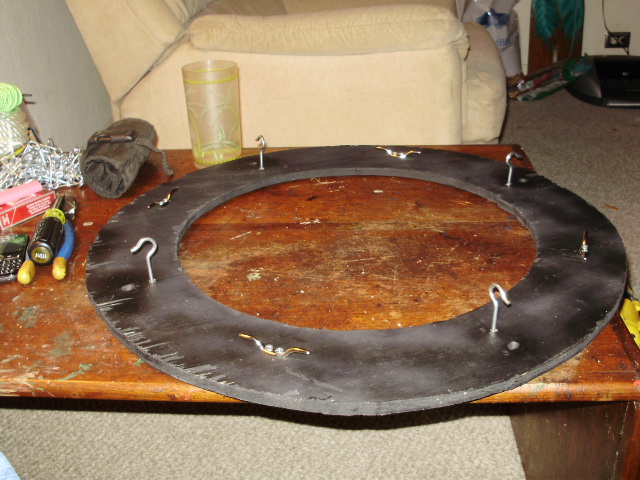
So in the photo above, you see the rope cleats for securing the cord suspending the wind chime bell. So far this has proved to be the most simple and fastest way to adjust and secure the cord when you make large wind chimes. Honestly you are way up in the air on a pretty tall ladder when you do this so speed and cord holding reliability are a big factor. Directly in front of the J-hooks is the port where the large wind chime suspension cord passes through the halo. Make this hole much larger than the cord, flange it out and smooth finish this port so as to not abrade the cord over time. I learned this point the hard way in making large wind chimes. The J-hooks face outward and in the next photo you will see how this all comes together and this is how to make a large wind chime. This is actually the most fun wind chime parts.

At the very top is the rope. Go heavy duty here and over do it. One because this is where 100% of all stresses are focused into one point when you make large wind chimes. Two, thicker rope is easy on the tree and we do not want to hurt the tree. Next are the spring cleats, one up and one down. The upper spring cleat is for the rope and the lower holds all of the quick-links connecting the chain. So there are two spring-links and five quick-links in a four chime halo. The quick-links connect to the dog chain. Five in this set up with one chain going down to each of the four j-hooks and one on the center for hanging the hammer platter lower on down the wind chime later on.
Here are some things you need to know when you make extra large or giant wind chimes. Some of the topics I cover will seem obvious and there are also some things that you would think are important where in reality, they are not.
The first thing you need to do when you make large wind chimes is to get your hands on some pipe. This is going to come in handy rather quickly and I know, this seems to be a no-brainer here but trust me, it is essential and some people screw this part up. Choose your metal for making your big, large, or giant wind chimes, Aluminum, Copper, or Steel and get ready to have a lot of fun with your new hobby. From the top hook to the bottom of the wind sail I will try to be as all inclusive as I possibly can be. My page on Metals says alot about wind chime tubes and/or bells. This is how to make wind chimes.
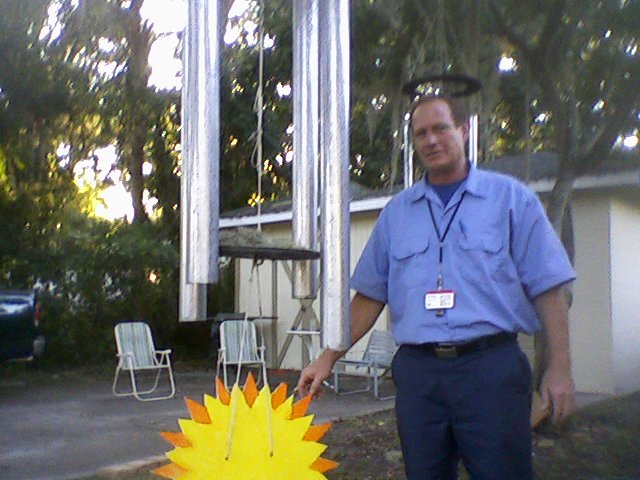
Here is a list of the parts I use in when I make large wind chimes. I use heavy duty parts for dealing the with enormous static hanging weights and huge wind loads. All of these parts can be rounded up at any Home Depot for making large wind chimes. Here is a list of wind chime parts.
3/8’s Spring Links – at the top of the halo for the rope connection for large wind chimes
Quick Links – connect the spring links to the dog chain
Screw hooks / J-hooks – connect the halo portion to the dog chain
Rope Cleats – connect and lash the braided cord to hang the large wind chimes through the ports drilled in the halo
Screw eyes / eye hooks – go in tha hammer platter top and bottom to suspend the braided cord 1 from the halo 2 to the wind sail – hammer in the middle
Dog chain – from the J hooks to the quick links
Wire – for the chime axels 16 gauge galvanized in this situation – use a matching metal for whatever type of bell you use, copper for copper bells, steel for steel, aluminum for aluminum
Twisted nylon poly rope – braided is better – 3/8s is a minimum 1/2 inch braided is recomended
Diamond braid poly cord – to suspend the actual chimes
4oz pyramid fishing sinkers – use just one to counter balance the hammer platter
Spray paint minimum – brush on rustoleum is my favorite when making large wind chimes
24x24x 1/2 inch plywood handy-boards from home depot
2 inch steel tubing galvanized from home depot electrical department
Below is a photo of the necessary parts I needed to make a large wind chime. These are my wind chime parts. This, for me, is what I use to make my smallest at ten feet wind chime yet the most pretty wind chimes I can make. My wind chimes are pretty and pretty big. So lets make some large wind chimes! This is everything I noted from the list above for large wind chime parts.
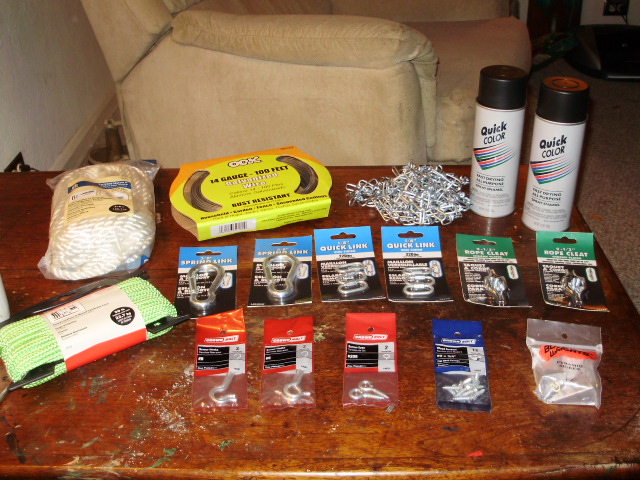
And in the next photo I show the basics of the hanging order of the hardware and wind chime parts from top to bottom. Spring links to the quick links, quick links to the dog chain, dog chain connected to the J-hooks, knee bone connected to the leg bone (sorry, I thought that was funny)
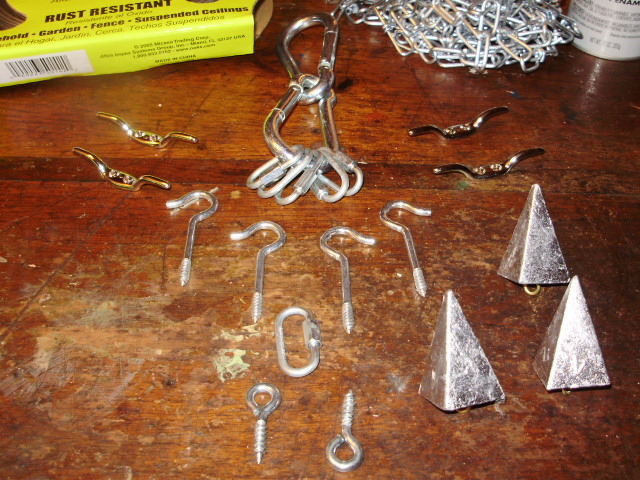
When I make large wind chimes, this next photo below is of the tubing and plywood I use for the main-stay of the chime set. The plywood is a 24 inch square that is 3/4 of an inch thick. One piece I use to make the halo and the other piece is for the hammer platter that actually strikes the chime. The tubing I use to make the actual chimes is 2 inch galvanized thin-wall steel. It is light weight and is extremely rust resistant. Painting them any color harms nothing and does not change the low tone when making a large wind chime at home. You can cut the pipes to any length you wish yet I suggest the difference between the longest and shortest chime be no more than one foot. Do not worry about balancing things at the halo. It will hang pretty level regardless of weight differences because the chains will not allow it to hang off balance when we make a large wind chime. This is the starting point of how to make wind chimes and wind chime parts.
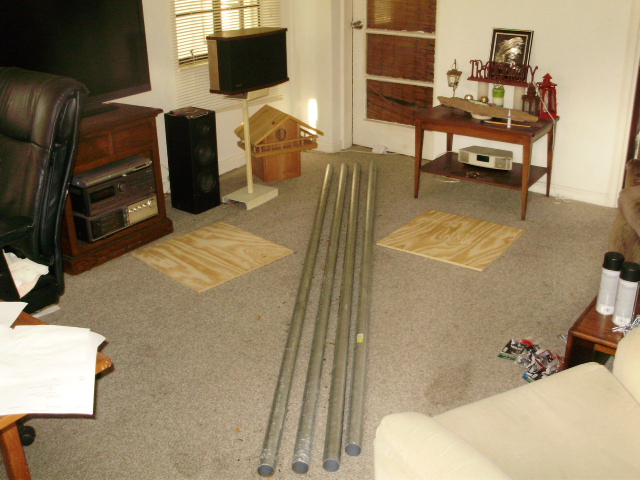
Next is a very critical point when I show you how to build wind chimes, large wind chimes. Where to drill the hole in the pipe for the suspension axel so it actually sounds like a bell instead of a bad windy day at the muffler shop. I see so many people screw this part up, this is an important and critical part for making wind chime tubes and bells. I see so called professional wind chime companies hanging them from the very top of the pipe and I have made that mistake myself and paid dearly for the lesson. The math formula is the same for any length and diameter of pipe when you make a wind chime. Take the length of your pipe, in inches, and multiply that by 22.4% no matter what the length is. Each chime will have a a slightly different suspension point based on its length and this is very important. You want to suspend your chime bell by one of the few points along the chime that are neutral and not moving when they vibrate after being struck by the hammer platter being pulled along by the wind sail. IT is so very important of using the .224 multiplier of locating your suspension point for any given length of pipe which is critical if you want to know how to make a large wind chime and how to make a large wind chime at home.
So now that we have all of these large wind chime parts together in one place, it’s time to make some very pretty wind chimes. When I make large wind chimes, extra-large is just a starting point. Large and Giant wind chime construction is what I am going for because I like the look when they are in a large mature tree, and I do like the sound, the deep tone wind chimes sound so nice and the resonance that they emit in any breeze is amazing.
Update from 05/19/2013 pm
for Brenda & Bill-
Instructions and suggestions for making wind chimes – how to make a wind chime and how to build a wind chime
Home Depot shopping list wind chime parts
Hang-rope – Braided nylon 3/8’s or larger
2″ EMT – 4 10′ sticks of pipe
1 tube – cheap ass bath-tub caulk/adhesive (for gluing down the counter-weight)
Nylon cord (kite-string)
Braided cord (for suspending the bells) update – use chain
plus one impulse item that you needed but wouldn’t make a special trip to home depot
First things first – Go to Home-Depot and round-up all of this stuff, then lets go home and play with your new wind chime parts!
I use a spark-plug socket and the kite string to begin. Locate the branch you want to use (preferably a really high, outer branch for optimum swing and sway during storms) then launch the socket and string combo over the branch and allow it to come back to you on the ground. Now that you have a tug-string over the branch of your desires we are ready to use that to pull up our working “hang-rope”. In the Hang-rope, tie a nice, large loop, and finish it with a bow-line knot. Now from the other end of the hang rope (the end w/o the knot and loop) tie that end to the kite string and pull it back up and back over the branch back to you on the ground. There, now your hang-rope is in the tree and your feet have never left the ground! Slide the un-knotted end of the hang-rope through the loop you made and simply pull your knot back up and into the tree. (if you wish, you can leave the kite string attached to your loop should you ever wish to retrieve the rope back down from the tree for whatever reason) This could be very important if your wife should want to change your mind. Tell her no, you got it right the first time.
EMT – 8-9 foot bells for a large wind chime wind chime parts
Cut ( get out your hacksaw, it cuts pretty easily)
Measure/Cut with the 22.4% formula per wind chime tubes length – this is how to make a wind chime and build a wind chime
One @ 96 inches and locate the axel port at 21 1/2 inches
one @ 100 inches axel port at 22 1/2 inches
one @ 104 inches axel port at 23 3/8 inches
one @ 108 inches axel port at 24 1/4 inches
You can check my math using 22.4% of the pipes over-all length to locate the axel ports of where to suspend these large wind chimes, this is critical.
Axel ports can be drilled out with a 3/8’s drill bit.
File any burrs off of the cut ends of the tubing ( the cut ends are now the bottom of the chimes)
Now, use the braided cord, and tie a large loop again and secure this with a bow-line knot. Using a push-stick of some sort, just tape the cord to the push-stick and insert it into the top of end of the pipe down to the axel port. Insert the axel catching the cord and retrieve the cord back out. This should leave you with two cord ends coming out of the pipe. Slide one end of the cord through your loop and allow it to return back into the pipe, this should form a double loop around the axel you inserted. This instantly doubles the strength of your cord. Now, gently pull on the cord and form a V in the axel as you pull. This centers the cord in your pipe. With tension on the cord, fold the left-over axel outside of the pipe up-wards and use needle-nose pliers to roll this into a loop so it will not pull out of the ports.
Now, with the pipe all cut and finished, ports drilled out and axels installed with hang cords attached we are now ready for the next step in making wind chimes. I’m trying to help you build wind chimes.
Take all of your chimes and lay them down next to each other lining them up as per the axel. Disregard the pipes length for the moment. It is important that you match all of the axels into a single line. The ends of the pipes are going to be different and that is ok, we want to align the axels for measuring purposes. Using the largest (tallest) pipe measure from the top of that pipe on the hang-cord and mark the cord at about 12 inches. Use that mark on the hang-cord to transfer this measurement to the other chimes cords. These marks will show you how high to hoist the chime suspension cord into the Halo when actually hanging the chimes so when you are done hanging the chimes, the axels are all at the same elevation. Axel alignment is critical when you build a wind chime. This is important stuff when you are making a wind chime.
The Hammer/Platter – hang this from the center and down low enough on the chimes to hit about 6 inches from the bottom of the shortest chime.
All of the art work on the wind-sail is entirely up to you..
Please contact me if you have any questions…I am here on-line everyday and every night. I am also here all weekend long, every weekend. Most of the time I will get back to you right away and in the worst case scenario the turn around is 24 hours for a response. I would truly seriously enjoy hearing from you no matter where you are on the planet if you are interested in knowing how to make a wind chime.
Thank you for visiting and I can not wait to hear from you! Visit me on my contact page!
Mark Ross Extreme Wind Chimes.com
email me from my contact page if you have any questions about knowing more about how to make a wind chime or how to build a wind chime..please.
update 06/01/2013
another email from a client – questions about large wind chimes…wind chime parts and specifically the details of making wind chimes, large wind chimes.
They asked about the Halo and Hammer dimensions and cuts for the plywood portion of the large wind chime, inside and outside diameters and the disaskingtance from the hammer to the bells. Very good questions and a thank you shout-out to Don M in Columbiana, thank you for . Don asked what were my measurements on the plywood.
Yes, the center cut IS the Hammer. Drill your jig-saw blade-hole port so it is in the Halo portion of the plywood and not in the hammer portion of the cuts we are about to make. Trust me, no one notices a notch in the Halo 19 feet up in the air but a notch in the hammer will have many people asking dumb-assed questions you do not want to field when it comes to any conversation about your large wind chimes.
I offset my cord ports in the Halo for the actual hanging cord of the chimes to pass through per “the pipes diameter” so that in a static situation with no breeze, the hammer is approximately 2 inches away from any wind chime tube / bell at any time. 2″ minimum!! I know this sounds like a huge distance because we are talking about a four inch swing before any tone is emitted but you will thank me later when you make wind chimes for yourself.
Paint only the top and the sides of the Halo, leave the bottom raw unpainted plywood. The plywood breathes and this reduces warp over time. The Halo is going to warp anyway but only very slightly, it is barely noticeable and not worth worrying about. This is natural and normal. This is not important unless you are one of those anal-retentive types who want to make it important. In that case you should probably not be making wind chimes. Anal-retentive type of people also worry about what specific notes the chimes will produce, known as tuning and what cord the chimes are playing. I swear to my higher power, if I played any note on a large wind chime bell, could you tell me what note or cord it was with out using expensive electronic equipment? If so, you have no business in the wind chime hobby. Anal retentive people worry about unimportant things.
1/8 corner-round the hammer platter on the edges. Paint it entirely top and bottom but NOT on the edges where it strikes the bells. Use a file or a router that is not important, just smooth the edges off and slightly round the corners.
again, if you have any questions about how to make wind chimes please email me from my contact page. I answer most email with in 24 hours and on most evenings and weekends I will answer right away so there is little wait time for an answer when you want to know how to build a wind chime.
Any question on how to make wind chimes is welcome, ask about where to find wind chime parts, wind chime ideas, how to hang wind chimes, wind chimes for sale, or wind chime kits. I would love to hear from you.